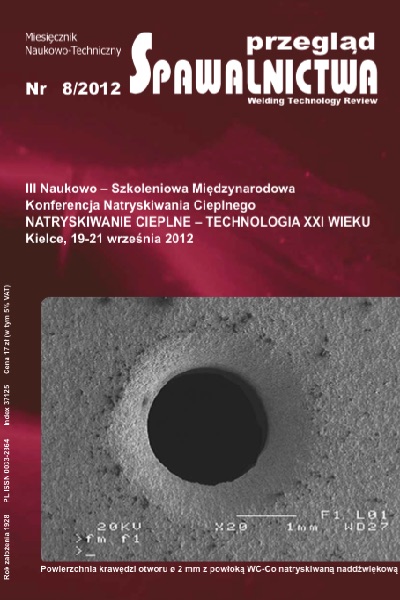Mikrostruktura powłokowych barier cieplnych natryskiwanych metodą APS z zastosowaniem nowych proszków ceramicznych
##plugins.themes.bootstrap3.article.main##
Abstrakt
W artykule przedstawiono wyniki badań mikrostruktury oraz odporności na utlenianie powłokowych barier cieplnych wytworzonych metodą APS. Jako podłoże zastosowano stop Rene 80. międzywarstwę stanowił wieloskładnikowy stop meCrAlY. Zewnętrzną warstwę ceramiczną stanowiły proszki tlenku cyrkonu stabilizowane tlenkami itru, magnezu i wapnia. Proszki te mogą być stosowane zarówno w procesie natryskiwania metodą APS, jak i w warunkach obniżonego ciśnienia LPPS. Badania przeprowadzono z zastosowaniem mikroskopii świetlnej i elektronowej mikroskopii skaningowej. Wykonane zostały także pomiary porowatości wytworzonej warstwy. Wykazano, że zastosowanie nowych proszków ceramicznych zapewnia możliwość wytworzenia powło- kowych barier cieplnych, jednak ich maksymalna temperatura pracy, poza konwencjonalnym tlenkiem cyrkonu stabilizowanym tlenkiem itru, jest niższa i nie zapewnia ochrony przed utlenianiem powierzchni elementów silnika lotniczego.
The microstructure of thermal barrier coatings sprayed by APS with new ceramic powders
Abstract
The article presents the results of microstructure and oxidation resistance of thermal barrier coatings produced by APS. Rene 80 alloy is used as substrate and meCrAlY alloy as an interlayer. For outer ceramic layer are used zirconium oxide powders stabilized with yttrium, magnesium and calcium oxides. These powders may be used in both the APS spraying method as in conditions of low pressure LPPS. The study was carried out with the use of light microscopy and scanning electron microscopy. The effective porosity of layer were also measured. It shows that the use of new ceramic powders provides the ability to produce thermal barrier coatings, but their maximum operating temperature, except the conventional zirconium oxide stabilized with yttrium oxide, is lower and does not provide protection against oxidation of the surface of air- craft engine components.
Pobrania
##plugins.themes.bootstrap3.article.details##
Creative Commons CC BY 4.0 https://creativecommons.org/licenses/by/4.0/
Artykuły czasopisma Welding Technology Review (Przegląd Spawalnictwa) publikowane są w otwartym dostępie na licencji CC BY (licencja Creative Commons Uznanie autorstwa 4.0 Międzynarodowe). Licencja CC BY jest najbardziej otwartą dostępną licencją i uważaną za „złoty standard” w formule otwartego dostępu; jest również preferowany przez wielu fundatorów badań. Licencja ta umożliwia czytelnikom kopiowanie i redystrybucję materiału na dowolnym nośniku i w dowolnym formacie, a także zmienianie, przekształcanie lub budowanie na nim materiału, w tym do użytku komercyjnego, pod warunkiem wskazania oryginalnego autora.
Bibliografia
D.S. Rickerby and H.C. Low, in Proc. 4th European Propulsion Forum (Royal Aeronautical Society, London, 1993 no. 12.
Coatings for High Temperature Structural materials, national materials Advisory Board Report national Academy Press, Washington, DC, 1996.
G. Lehnert and H. meinhardt, Present state and trend of development of surface coating methods against oxidation and corrosion at high temperatures, Electrodeposition and Surface Treatment Vol. 1, Iss. 1, September 1972, 71-76.
D. Driver, D.W. Hall, and G.W. meetham, in The Development of the Gas Turbine Engine Applied Science Publishers, London, 1981.
G.W. Goward: and D.H. Boone, mechanisms of formation of diffusion aluminide coatings on nickel-base superalloys, Oxiddation of metals 3, 1971, 475-496.
G.W. Goward Progress in coatings for gas turbine airfoils, Surface and Coatings Technology, Volumes 108-109, 10 October 1998, s. 73-79.
J.R. nicholls, Designing oxidation-resistant coatings. JOm Journal of the minerals, metals and materials Society, 2000, Vol. 52, no. 1, s. 28-35.
F.T. Talboom, R.C. Elam, and L.W. Wilson, Evaluation of Advanced Superalloy Protection Systems, Report CR7813 national Aeronautics and Space Administration, Houston, TX, 1970.
D.K. Gupta and D.S. Duvall, Coatings for Single Crystal Superalloys. The minerals, metals and materials Society, Warrendale, PA, 1984.
http://www.sulzermetco.com/en/desktopdefault.aspx/tabid-1741//3381_read-5289.
R. Vaßen, m. O. Jarligo, T. Steinke, D. E. mack, D. Stöver,, Overview on advanced thermal barrier coatings Surface and Coatings Technology, Vol. 205, Iss. 4, 15 november 2010, 938-942.
A. nusair Khan, I.n. Qureshi, microstructural evaluation of ZrO2mgO coatings Journal of materials Processing Technology, Vol. 209, Iss. 1, 1 January 2009, 488-496.
M. Goral, m. Drajewicz m. Pytel S. Kotowski, Characteriza- tion of powders used for LPPS Thin Film plasma spraying of thermal barrier coatings, Journal of Achievements in mate- rials and manufacturing Engineering, Vol. 47 Iss. 2 August 2011, 157-165.
G. Moskal, B. Witala, A. Rozmysłowska, metallographic preparation of the conventional and new TBC layers, Archives of materials Science and Engineering, Vol. 39 Iss. 1. Septem- ber 2009, 53-60.
G. Moskal, Criteria of microstructural assessment of the conventional and new TBC layers, Archives of materials Science and Engineering, Vol. 38, Iss. 1 July 2009, 19-25.
G. Moskal, The porosity assessment of thermal barrier coatings obtained by APS method, Journal of Achieve- ments in materials and manufacturing Engineering, Vol. 20 Iss. 1-2, January-February 2007, 483-486.
